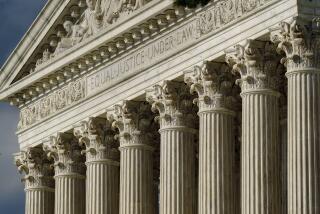A Machine That Would Go of Itself by Michael Kammen (Knopf: $29.95; 530 pp.)
I once heard a student ask U.S. Supreme Court Justice William Brennan how he could decide a case in which the Constitution and his sense of justice pointed to different conclusions. Justice Brennan scoffed at the question, stating that in his more than 20 years on the bench, he had never seen a case where his understanding of the Constitution conflicted with his sense of justice. Michael Kammen’s new book on the symbolic meaning of the Constitution amply demonstrates that, whatever its philosophical weaknesses, Brennan’s view of the relationship between law and morals has always been the quintessentially American position. We all support the Constitution without reservation because each of us finds in it the message he or she seeks.
Conservatives like Chief Justice William Rehnquist like to portray this tendency to read the Constitution as reflecting one’s own social views as a uniquely “liberal” vice. Kammen shows, however, that if anything, conservatives have been more likely than liberals to support Supreme Court intervention to protect their view of a just society. For instance, it was conservatives on the race issue in 1857 who welcomed the Dred Scott Decision protecting slavery, and conservatives on social welfare issues in 1905 who supported the controversial Lochner decision striking down what we now consider a run-of-the-mill labor law. And, of course, Rehnquist himself has been known to indulge in a little selective judicial activism when he believes that the Congress has transgressed its proper role vis-a-vis the states or the presidency.
Kammen convincingly shows that the Constitution has become a powerful symbol of national unity just because each group has been able to see it as a mirror of its own goals. Controversial readings of the Constitution have always been within the rules of the game; the cardinal political sin is to reject the Constitution itself. Kammen perceptively points out that while many Northerners saw the South’s defense of slavery as a respectable constitutional position, its decision to leave the union was viewed as treason.
Of course, we have paid a high price for this symbolic unity. A Constitution which can be read to mean anything is perilously close to a Constitution that means nothing. Consensus based on ignorance is not a secure basis for constitutional government, and Kammen demonstrates that Americans’ fervent faith in the Constitution as a symbol is wed to an abysmal ignorance on questions of constitutional law.
He points out several reasons for this ignorance, including the Supreme Court’s penchant for secrecy and its disregard for explaining its decisions to the public. Another reason is the refusal of most of the press to pay proper attention to constitutional issues, and for those papers that do cover constitutional issues to see them as a form of athletic contest where what counts is who won or lost, not the underlying basis for decision. For instance, while the Supreme Court ruled in favor of the white medical school applicant in the 1976 Bakke case, the reasoning clearly upheld the constitutionality of affirmative action programs, a fact the press underplayed, thus misinforming the public on the decision’s true import.
The root cause of public ignorance on constitutional questions is placing the Constitution into the custody of lawyers. Constitutional law should be an ongoing dialogue within our tradition among all citizens over the future shape of our political society. Yet, in fact, it has become the property of lawyers who speak an esoteric language which excludes most citizens and shears constitutional questions of their moral qualities.
I sometimes boast to my constitutional law classes that a simple question in race discrimination is just as intricate and technical as the most complicated issue in corporate taxation; I ignore the question of whether it makes sense to translate what is essentially an issue of political morality into a problem of legal calculus. Certainly, it disqualifies 99% of the population from making an informed contribution to the debate. No wonder public discourse never rose above cries of “racism” or “reverse discrimination” in the Bakke decision. And this unintelligibility of the constitutional discourse inevitably contributes to the public’s misunderstanding of the decision itself.
Demystifying constitutional discourse can only take place over time, but a good first step would be to appoint non-lawyers to the Court. After all, what qualification, other than possession of a law degree, favors Edwin Meese over, say, George Shultz?
Prof. Kammen has written a provocative book raising important issues. I must admit, however, that I find his execution uneven. Some chapters, especially the first, are truly profound; others are so thin they sound almost gossipy. I couldn’t resist the mental picture of Kammen in his den, surrounded by shoeboxes full of clippings, determined to use every scrap. Still, I cannot think of anyone who will not learn much both new and important in this book, and I recommend it highly.
More to Read
Sign up for Essential California
The most important California stories and recommendations in your inbox every morning.
You may occasionally receive promotional content from the Los Angeles Times.










